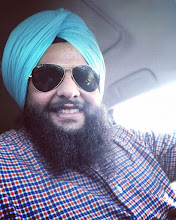Posted by
Jugraj Singh Randhawa
Zorawar Singh (28 November 1696 - 26 December 1705), the third son of Guru Gobind Singh, was born to Mata Jito ji (also known as Mata Sundari ji) at Anandpur on 28 November 1696 and was barely nine years old at the time of the evacuation of Anandpur on the night of 21-22 December 1705.
Since the death, on 5 December 1700 of Mata Jito ji(1), Mata Gujari, his grandmother had been especially attached to young Zorawar Singh and his infant brother, Fateh Singh. She took charge of both as the column moved out of Anandpur.
While crossing on horseback the rivulet Sirsa, then in spate, the three were separated from Guru Gobind Singh. Their cook, Gangu, who had also succeeded in crossing the stream, escorted them to his own house in the village of Kheri, now known as Saheri, near Morinda in presentday Ropar district.
While unsaddling the horse he saw that there was some valuables in the saddlebag. This tempted him to treachery. He not only stole the saddlebag during the night, but also planned to betray the fugitives to the government in hope of a reward.
Treachery by Gangu
On the morning of 21 December 1705, the day of the fateful battle of
Chamkaur,
Baba Zorawar Singh ji, along with
Baba Fateh Singh ji and their grandmother, was taken into custody by Jani Khan and Mani Khan Ranghar, the officials at
Morinda after their cover was blown by Gangu who reported them to the Mughal authorities.
They were despatched on the following day to
Sirhind where they were consigned to the Cold Tower (
Thanda Burj) of the Fort. This spot is marked by the famous
Gurdwara Fatehgarh sahib.
On 23 December 1705,
Baba Zorawar Singh ji and
Baba Fateh Singh ji were produced before the faujdaar,
Nawab Wazir Khan, who had just returned from
Chamkaur with his feudal ally, Nawab Sher Muhammad Khan of Malerkotla.
Wazir Khan tried to lure the
Sahibzadas to embrace
Islam with promises of riches and honours, but they spurned the suggestion. He then threatened them with death, but they remained undaunted. Death sentence was finally pronounced.
Upon Sher Muhammad Khan's intercession for the innocent children to be spared their lives, they were given some more time to ponder over the suggestion to convert.
Sahibzada Zorawar Singh ji and his brother spent another two days of severe winter in their old grandmother's lap in the
Cold Tower.
Atrocity by the Mughals
Still adamant, they were, on 25 December 1705, ordered to be sealed alive in a wall. According to tradition, as the masonry around their tender bodies reached chest high, it crumbled. The
Sahibzadas were sent to the Cold Tower again for the night. The next day, 26 December 1705, the alternative of conversion being again turned down,
Baba Zorawar Singh ji and
Baba Fateh Singh ji were martyred by sealing alive in a wall.
The aged
Mata Gujari Kaur ji, who had all along been kept in the Cold Tower, only a little distance away, breathed her last as the news reached her ears. Mata Gujari Kaur ji through upbringing of her grandsons played such an important role in
Sikhism that as
Sikhs, we can owe our existence to her.
It was due to her teachings that 6 year old and 9 year old did not bulge from their Dharma and attained martyrdom., thus continuing and emphasizing the institute of martyrdom in Sikhism.
Seth Todar Mall, a wealthy merchant of
Sirhind, performed the cremation of the three dead bodies the following day. The site of the fateful happenings, since christened
Fatehgarh Sahib, close to the old town of Sirhind, is now marked by four Sikh shrines. A religious fair is held here from 25 to 28 December every year to honour the memory of the martyrs.
Death of Mata Jito in 1700 questioned
Following the link to
Mata Jito ji one finds that Mata Jito (also known as Mata Sundari ji) "…Consequent upon the evacuation of Anandpur on the night of 21-22 December 1705, Mata Sundari ji, along with Mata Sahib Devan (who adopted the name 'Sahib Kaur' after recieving Amrit), was escorted by Bhai Mani Singh ji to Delhi."
She lived for many years in Delhi after the death of her husband,
Guru Gobind Singh. The writer/s of this article have followed the same line of reasoning that earlier historians have followed — that as the young Sahibzadas were escorted out of
Anandpur by their grandmother that their mother had died earlier in the confused fighting that took place at Anandpur sahib.
See also
External Links
References
- 1. Kuir Singh, Gurbilas Patshahl 10. Patiala, 1968
- 2. Chhibbar, Kesacr Singh, Bansavalmama Dasan Patshahian Ka, ed. Rattan Singh Jaggi. Chandigarh, 1972
- 3. Sainapati, Sn Gur Sobha, ed. Ganda Singh. Patiala, 1967
- 4. Gian Singh, Giani, Panth Prakash. Delhi, 1880
- 5. Padam, Piara Singh, Char Sahibzade. Patiala, 1970
- 6. Dates changed in accordance with Nanakshahi calendar
These articles deal with
Char Sahibzade


Post a Comment